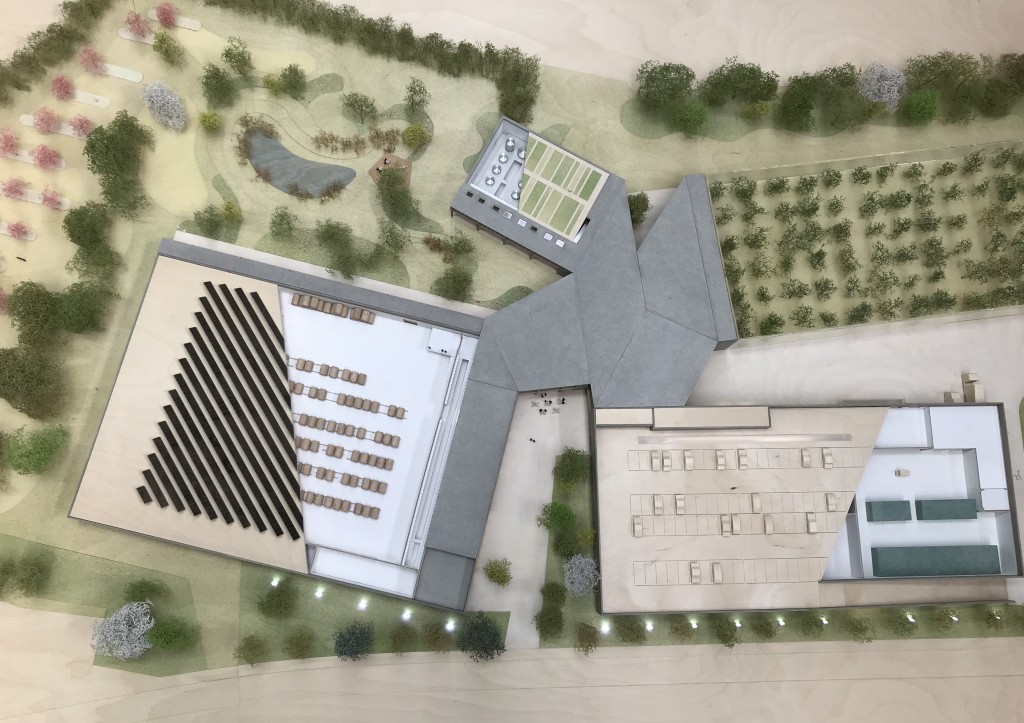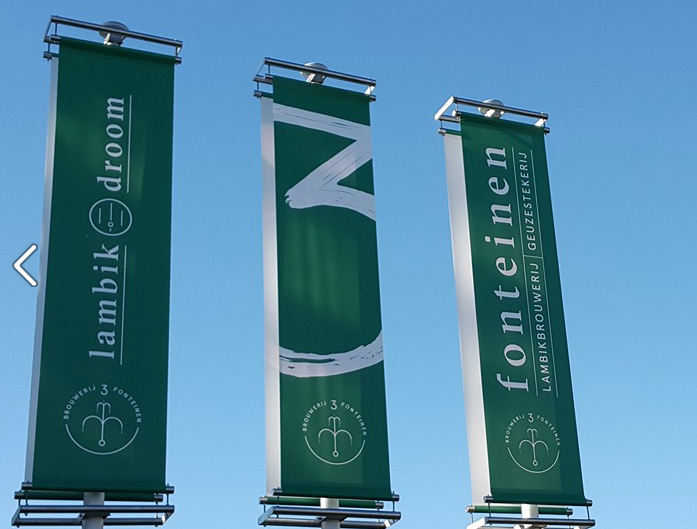
A note about 3 Fonteinen’s current ownership: when the lambik-O-droom was first opened, Armand held 51% of the shares in the business. After several years of working with his partners, Armand recently sold all of the rest of his shares (25%) to Van Obberghen, Blancquaert, and Duyck. Armand had already sold about half of his shares in 2018 so he could build a house of his own at the coast, so he could start enjoying his retirement, balanced, of course, with days in the lambik-O-droom.
While many lambic lovers may have heard via word of mouth that Armand has been sick in the last year or so, this fact has not been publicly touched on in any reporting, in respect for Armand. I can now confirm that Armand has indeed been suffering from a serious illness, and that the main reason he sold the rest of his shares to Van Obberghen, Blancquaert, and Duyck was to make certain that, should anything happen to him, that there would be no question of what might happen to his remaining 25% of shares. Armand wanted to make sure that his three partners will remain in full control of all of 3 Fonteinen’s future direction.
Werner remarked: “Armand is very much looking forward to the day that he will be back in the Droom again!” I’m told that Armand has been improving, and that many of the 3 Fonteinen team visit him frequently. So while some articles in the Belgian press seem to imply that Armand has withdrawn from the brewery and gone into full retirement, that is not an accurate view of the situation. Armand will return to the lambik-O-droom as soon as he is able!



As to Armand’s successor in brewing and blending, it is Michaël Blancquaert. Armand told me in October 2013: “Michaël became co-manager of the brewery a year ago, and I intend to impart my knowledge of lambic brewing and blending to him. That has been my ultimate dream for years, to pass my knowledge on to the next generation. In fact, it is Michaël that gave me the energy to start brewing here again. He added: “I want to give my knowledge and experience to the next generation. That’s the most beautiful thing that can happen to me now!”

So, the brewery is in very capable hands. I am certain of that because Armand told me on several occasions since 2011 that Michaël was “as fanatical about traditional lambic as me, and maybe even more fanatical,” and that Michaël was also “a very intelligent and hard worker, and the son that I never had.” Armand has complete confidence in Michaël as his heir and protege to the 3 Fonteinen legacy. While 3 Fonteinen is now comprised of a big team, there can be no question of who is in charge of the brewing and blending operations. Armand personally trained Michaël as a lambic brewer and blender over the course of a number of years. In fact, Michaël was never trained to brew any other style of beer. Armand told me some years ago, looking back on hiring Michaël: “I wanted to hire someone who was not trained as a traditional brewer, as brewing lambic is so different than brewing non-spontaneously fermented beers.”
For a detailed look at Two Brewing Days at Brouwerij 3 Fonteinen, see this previous article.

As to the details of the 3 Fonteinen expansion and plans for the new space: there will be a new brewing hall, a new lambik-O-droom tasting cafe, and an additional 4,000 hectoliters (hl) of lambic barrel aging capacity. A stand of 100 Schaarbeekse cherry trees is planned, and a park that will be open to the public.


In addition to the Schaarbeekse cherry trees that will be planted on the expanded site, which is adjacent to the current space, there are plans to add 3,000 more such trees around the Payottenland over the next eight years, with the help of enthusiastic, lambic-loving volunteers. Additionally, about ten to twenty beehives are envisioned for the new site. A small maltery could also be added some years down the road if needs warrant it.
As far brewing capacity and lambic production, Werner remarked: “In 2018, we produced 3,000 hectoliters (hl) of bottled lambic beers, with a storage capacity of 8,000 hl of lambic in barrels. We will gradually grow from the 8,000 hl figure to 12,000 hl (10,200 U.S. beer barrels) of lambic maturation capacity by the year 2027. In so doing, we will be able to grow up to 6,000 hl (5,100 U.S. barrels) of bottled production per year. This is logical, as the average time of a drop of lambic between the brew and further processing f.e. fruit maceration, and/or blending, is 2.5 years. And that even does not include bottle conditioning, which takes up to another 6 months at least, and is currently almost 9 months on average, and for some bottles, even a full year. Note that this still is a fraction of what most “micro” and Belgian breweries produce these days.” Indeed, that is the case. 5,000 barrels is a drop in the bucket to most medium and large breweries.



One of the reasons that 3 Fonteinen expanded in 2016 from its original site in Beersel to the much larger site in Lot, just 4 kilometers away, was to consolidate their multiple lambic barrel aging facilities into one space, as this made operations vastly more efficient. The move also added much more lambic barrel aging space. This new planned expansion will bring the total space occupied by 3 Fonteinen in Lot today from 5,500 square meters (about 59,200 square feet) to 12,000 square meters (that’s just a bit more than 129,000 square feet.)




About the new brewhouse that will be built in Lot, Werner had this to say: “First, and very importantly, let me say this: We do not aim to produce a ‘standardized’ lambic or geuze. So, we will continue to use the brewhouse in Beersel and the new one in Lot. In fact, we will brew in ‘parallel’ (eg, at the same time) with the new brewhouse that will be built in Lot.”
He added: “The altitude of the brewery site in Beersel is about 80 meters above sea level, much higher than the site in Lot, which is located 80 meters (about 87 yards) from the Zenne river, as well as the smaller Molenbeek river. So the differences in weather variables between the two locations are real. The microclimates are different, with the average temperature at night being about 1 to 2 degrees Celsius (1.8 to 3.6 degrees Fahrenheit) colder in Beersel than in Lot. Also, there are different wind directions, as well as different wind speeds, between Beersel and Lot.”
These factors are important because they can affect the spontaneous fermentation that occurs overnight as the hot wort sits in the coolship. There are different naturally occurring airborne wild yeasts and bacteria that are active that feed on the proteins and starches in the cooling wort, such as Brettanomyces Bruxellensis and Brettanomyces Lambicus. The number and variety of yeasts and bacteria can be affected by the overnight temperature, as well as the wind speed and direction.

So, let’s cover the current and future brewhouses before I tell you about the huge lambic aging cellar that will be built as part of the new lambik-O-droom (No, don’t scroll down yet. Have some patience.) The brewhouse in Beersel has a mash tun with a theoretical capacity of 50 hectoliters, but with the grains (barley and wheat) added to the mash, the amount of wort produced is about 40 hl (34 U.S. barrels) per brew. After boiling the wort for 5 hours, it is pumped into the double decker coolship, where the wort cools overnight. After this process, the yield from one brew is usually about 32 hl (about 27 U.S. barrels.)
“We do lose about 45% of the wort produced from the mash, after the wort is pumped into the boiling kettle, between the evaporation that happens during the long, five hour boil, and then evaporation in the coolship, in our Beersel brewhouse. But that’s lambic brewing,” Werner remarked.

He added: “The new brewhouse in Lot will be built with the aim for everything to be about 1.5 times larger than the one in Beersel. So we are looking to install a mash tun of about 75 hectoliters (64 U.S. barrels) and that will net about 45 to 50 hl (38 to 42.5 U.S. barrels) per brew after the boiling and coolship processes. Note also that the roof of the barrel room will contain solar panels.”
Werner commented: “While we are currently still studying this, we do intend to install a complete energy recuperation system in the brewery, as well as a water recovery, treatment, and recycling unit. We also intend to be CO2 neutral (as much as possible.)”


As to 3 Fonteinen’s double decker coolship in Beersel, which has a capacity of 40 hectoliters with its four separate, 10 hl coolships, it will remain unique to the Beersel location. “We plan to have ten coolships in the 10 hectoliter (8.5 U.S. barrel) size built and installed in Lot. The reason to have that many coolships is that we intend to brew twice a day on very cold winter days, which mostly happen in January and February. We will be able to brew twice per day on those very cold days by having two brewing shifts. So we will need this 100 hl of coolship capacity on such days.”

Werner also emphasized that they will be actually be brewing in Lot. “The new brewhouse in Lot will not be automated, it will be similar to the one in Beersel. As you have seen when spending a couple of brew days with Diego (Sachem) in Beersel, lambic brewing is hard work. It will be the same in Lot. We do not look for automation to make things easy. In fact, our overall project is going against the advice of those who told us we should consolidate our operations to one automated brewhouse, with one brewer, all in one place. But that is not our aim.”
Werner added: “We will likely brew about 80 days per year when both brewhouses are on-line, versus the 120 days per year that we now brew in Beersel.”

***CONTINUED ON NEXT PAGE***: More about the new lambik-O-droom cafe, and more…
If you like this website, please like our Facebook page
and our Twitter page <


Leave a Reply